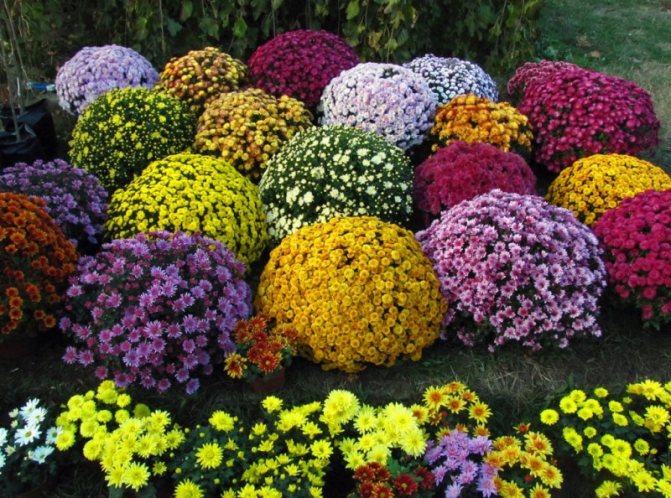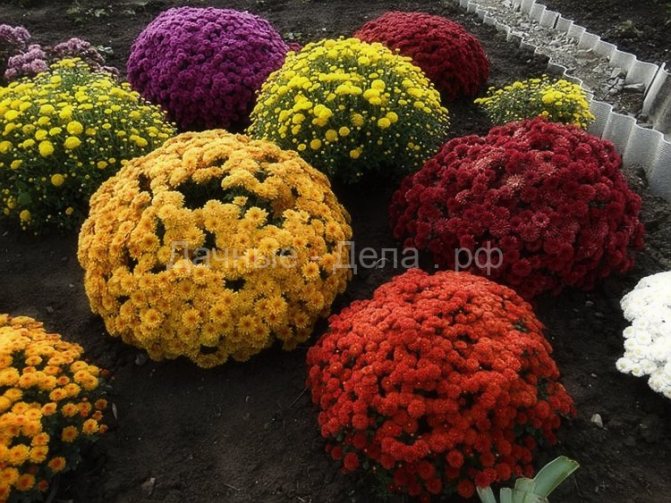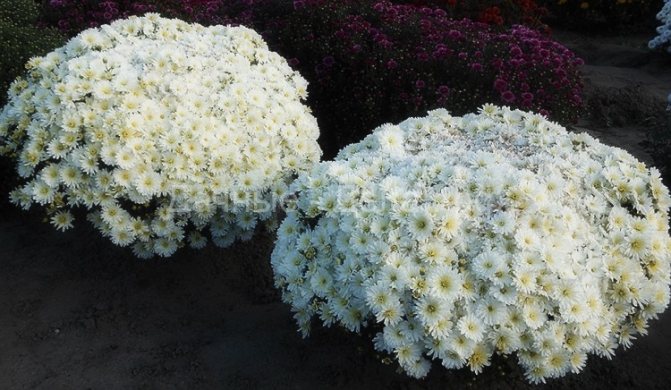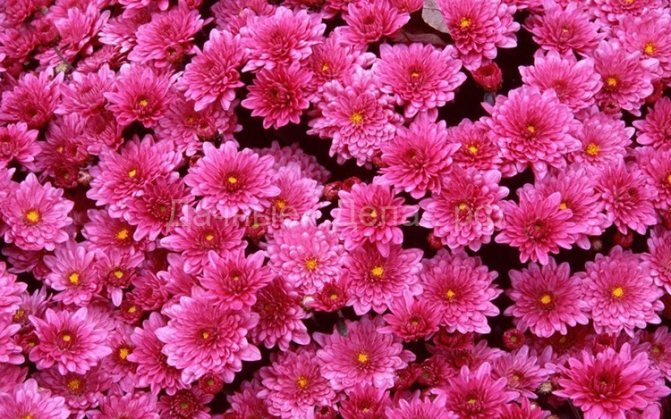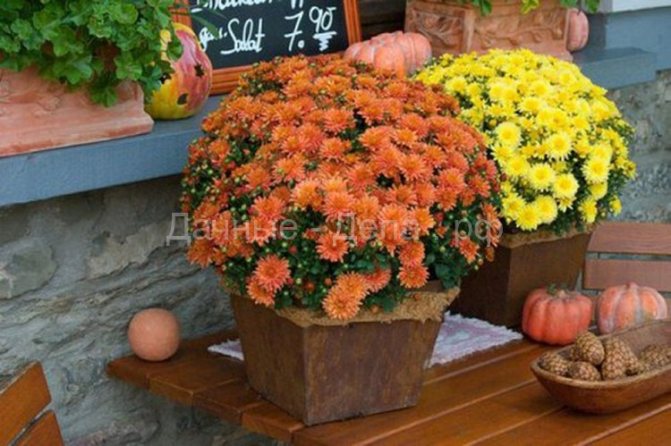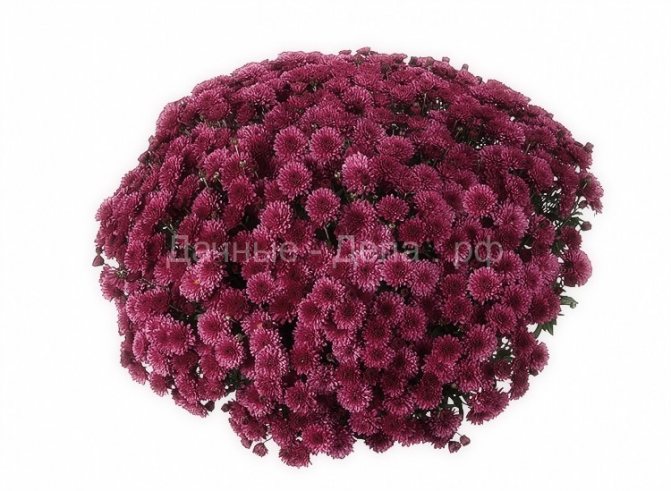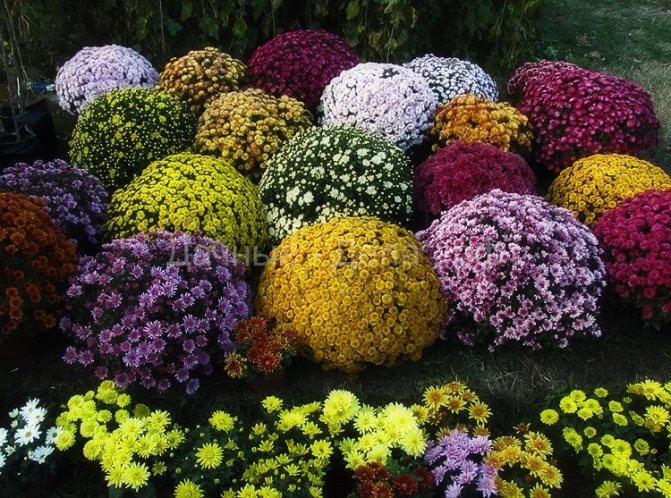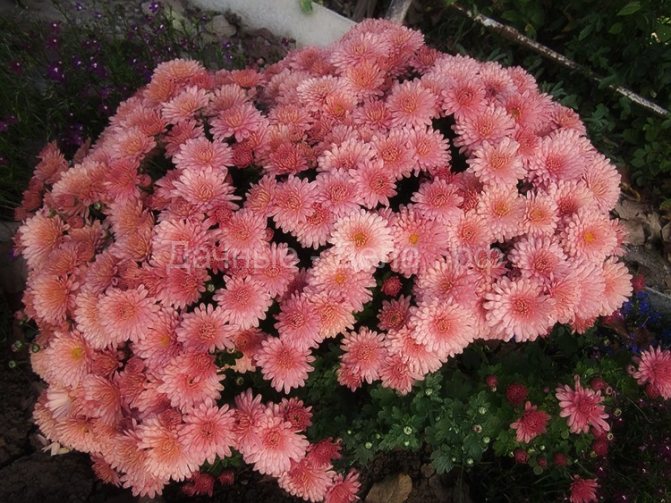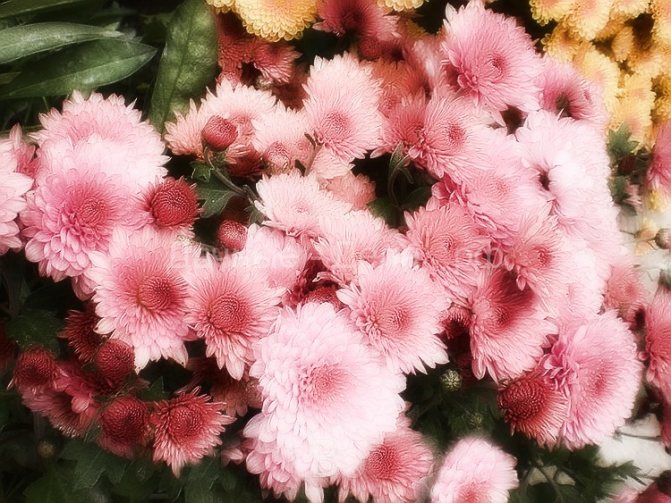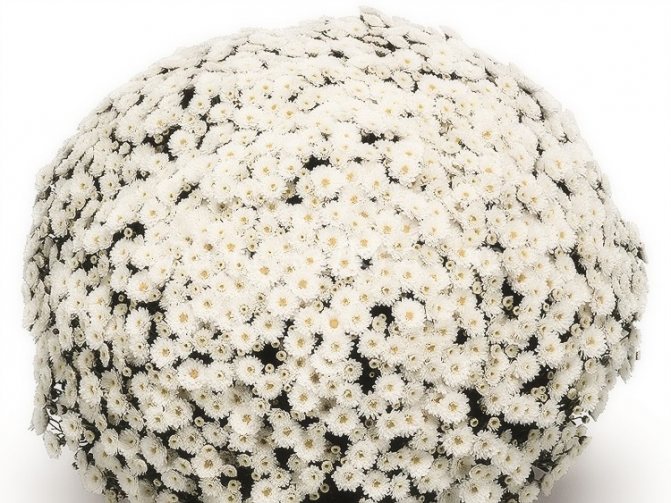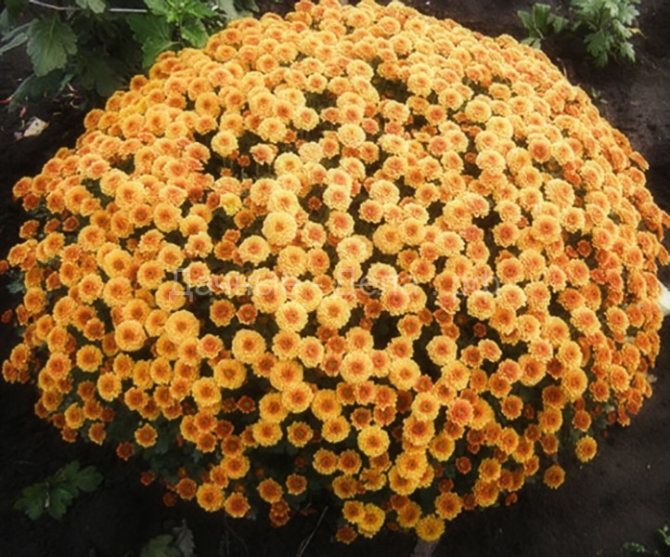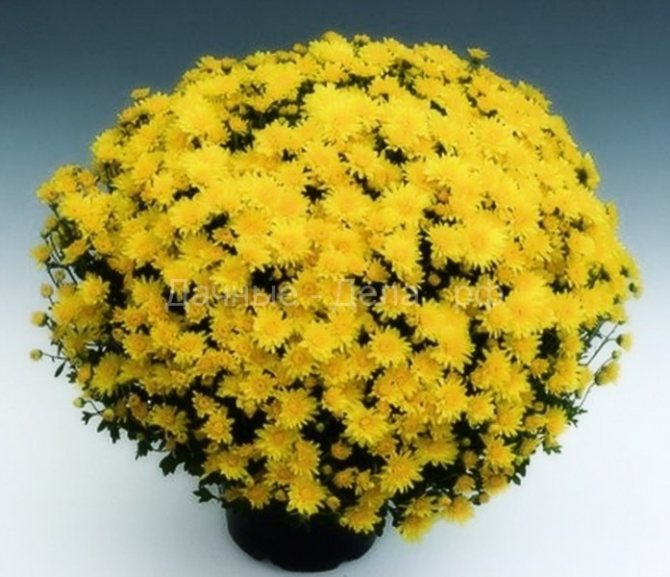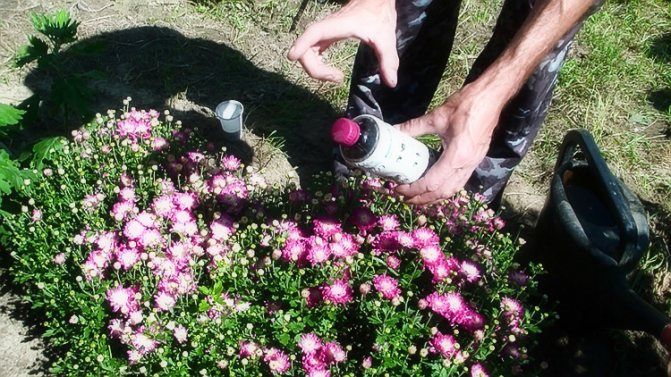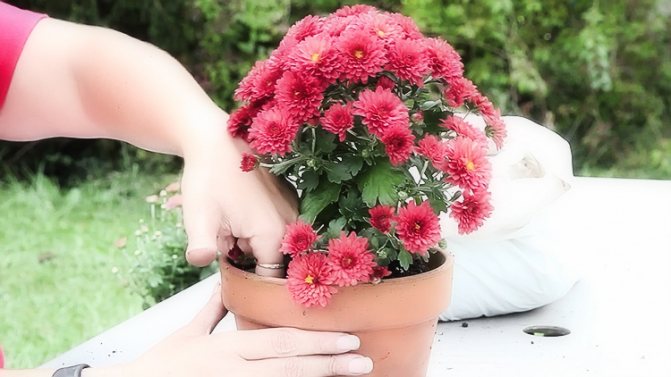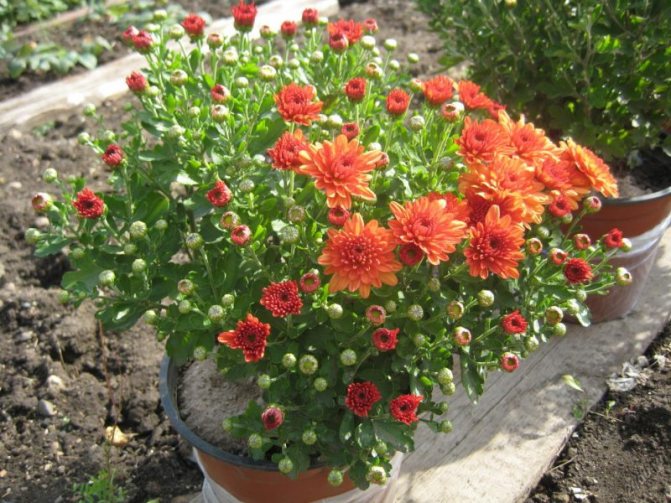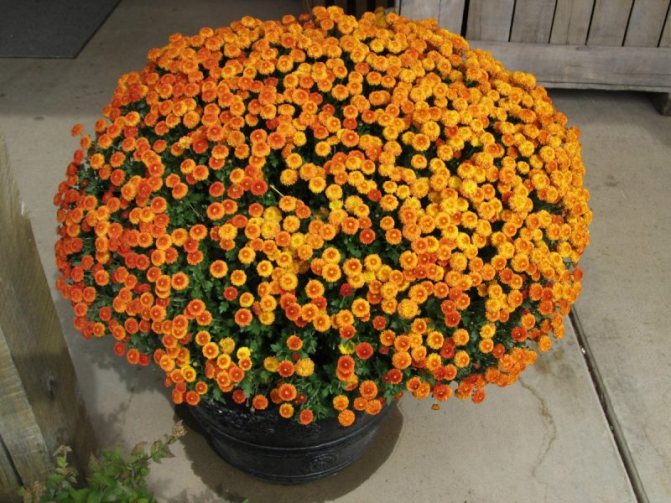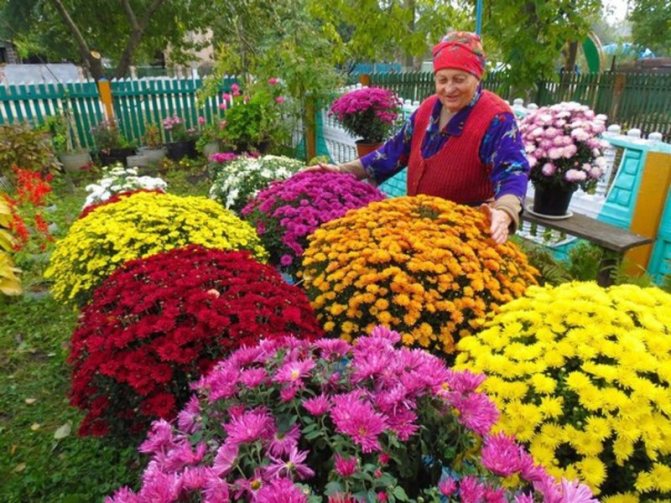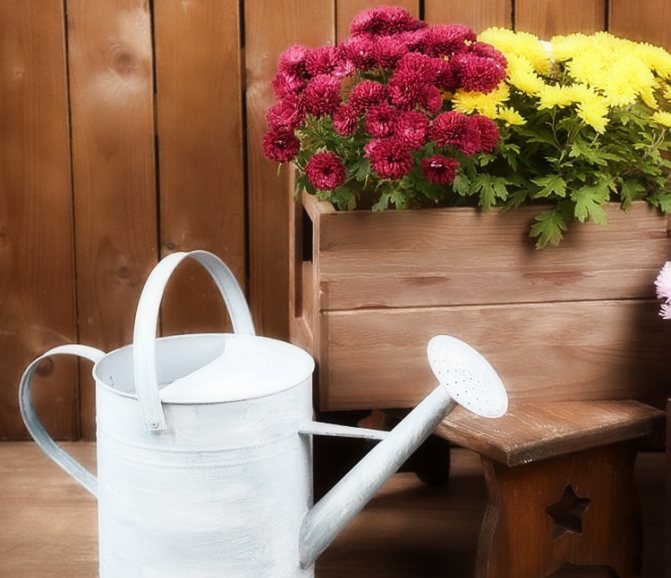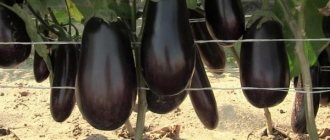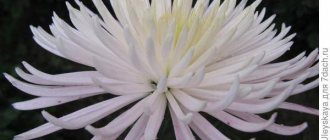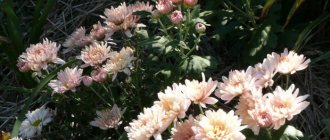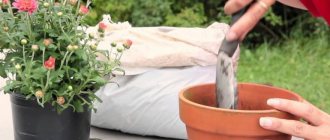Ball-shaped chrysanthemums, also called Multiflora, are very beautiful. They look like a solid blooming dome. These flowers are great for decorating a garden, front garden or small flower bed. Some of the varieties of spherical chrysanthemums are completely undersized. This makes them versatile for landscape decoration. In order for these flowers to turn out the same as in the pictures, you should properly care for them. If in the summer all flowers are looked after in about the same way, then the wintering of the Multiflora chrysanthemum is problematic and requires additional efforts.
What is spherical chrysanthemum multiflora
Multiflora or Chinese spherical chrysanthemum is a representative of the Compositae family, a type of garden bush chrysanthemums with numerous medium-sized flowers. This fairly young and very decorative variety was bred by breeders not for cutting, but for decorating the garden. When the multiflora blooms completely, it becomes like a picturesque flower ball, through which foliage is almost invisible. Low spherical bushes look perfect in curbs, slides, ridges and flower beds. It is noteworthy that the spherical shape of the bush is natural, forms independently and does not require special actions on the part of the gardener to maintain the outlines.
In addition to the special shape of the bush, multiflora differs from other chrysanthemums in terms of flowering. Its petals bloom very early, long before the onset of frost, most often in September, and the early varieties bloom in mid-August. Despite the fact that such varieties have begun to be actively developed relatively recently, today there are already several thousand hybrids that differ in the shape and color of the inflorescences.
The height of multiflora bushes on average rarely exceeds 40 cm, thanks to this property, it received another name - stunted chrysanthemum, spherical. Nevertheless, among the representatives of the family there are many taller specimens.
According to the height of the bush among the varieties of multiflora, varieties are distinguished
:
- undersized border chrysanthemums - 20-30 cm;
- medium-sized - 30-50 cm;
- tall - 50-60 cm.
Thus, for any flowering component of landscape design, there is a plant that is suitable in height.
The multiflora also differs in terms of the beginning of flowering.
:
- early varieties - August;
- medium - September;
- late - late September, early October.
By combining several varieties of multiflora on the garden plot, you can enjoy its abundant flowering from late summer to the very frost.
An important advantage of the variety is the absence of the need to prune plants, since the spherical shape of the bush is genetically incorporated in them. To make it more perfect, it is recommended to pinch the chrysanthemum (the top of the flower) when 2-4 pairs of leaves have already blossomed on it. But this is not at all necessary, and without additional pinching, the multiflora has a beautiful round shape.
The only significant drawback of such chrysanthemums is that most of their varieties do not differ in winter hardiness. In frosty winters with little snow, they freeze out even in the presence of shelter. You cannot leave them for the winter in the open field.
Post-flowering care
After the plants have faded, which happens in late October - early November, it is necessary to cut off the aerial part, leaving only 10 cm of the stem above the ground.Without this pruning, there will not be enough new shoots in the spring to make the bush look attractive.
Since in autumn chrysanthemums are often affected by powdery mildew, after pruning, it is necessary to spray the left petioles with a composition containing copper.
For the winter, the plants need to be covered with coniferous spruce branches and then covered with humus. This will be enough so that the bush does not freeze out, and also does not dry out.
Preparing chrysanthemum multiflora for wintering
Before growing spherical chrysanthemums, you need to understand: most varieties of chrysanthemums are not afraid of frost, they can be safely left to winter in the open field, but not multiflora. Like any artificially bred hybrid, it has lost some of the properties characteristic of its species. It is capable of surviving the winter under cover in the open ground only in the southern regions. In other regions, in order for the flowers to please the eye longer, from the first weeks of October they are covered with polyethylene at night, and dug out after flowering.
It is advisable to dig multiflora before the arrival of the first frosts, usually in early, mid or late October, depending on the latitude of the region. For wintering in the Moscow region and central Russia, the stems are cut off, and the roots are placed in boxes with earth, which are kept in a dark room at temperatures ranging from -5 to +3 ° C. The soil in the boxes should be moderately damp, not too damp or dry. So that by the time of planting in the ground, buds are formed on the branches, in April they are already exposed to the sun.
Before wintering, make sure the chrysanthemum is not suffering from diseases or pests. It is important. If the plant is sick with something, then most likely it will not be able to overwinter. Try to recognize problems and fix them while it's still warm outside.
In the same way, they provide wintering and multiflora, the cultivation and care of which is carried out in pots. The air in apartments in winter is too warm and dry for her, so in the fall, the potted multiflora is also cut off and stored in a dark, cool place.
It is also necessary to ensure that the preserved plants have a sufficient amount of minerals and nutrients in winter, etc. For this, from the beginning of September, fertilizing is introduced into the soil. Phosphorus-potassium fertilizers are best suited, they not only contribute to abundant flowering, but also contain all the substances necessary for a flower for a successful winter.
The basement or cellar where you store plants during the winter should be free of mold and mildew. To avoid their appearance, you should establish a high-quality ventilation system. If there are traces of fungus on the walls or on the floor, it must be scraped off, and the place must be treated with a solution of copper sulfate or used engine oil.
Video: chrysanthemum multiflora preparing for winter
Landing rules
Spherical chrysanthemums "Multiflora" are quite unpretentious and can be grown not only in open field flower beds, but also in containers, glazed greenhouses or in flower pots.
In central Russia, the most successful time for planting chrysanthemums is the first decade of May
if the weather is warm enough. The growing area should be well lit by the sun and well protected from gusts of cold winds. If the soil in the flower garden is heavy and dense, then it is necessary to improve the soil composition by adding sand and organic fertilizers. Rooting takes place quickly and easily on loose and well-permeable soils.
Ball-shaped chrysanthemum: planting and care
Growing spherical chrysanthemums, like any others, requires adherence to certain rules. A well-chosen place is one of them. Multiflora is photophilous, it is planted in sunny areas. With insufficient lighting, the shoots will stretch to the side where there is more light, and the shape of the bush will be distorted. In addition, a lack of light will negatively affect the timing and duration of flowering.
Multiflora should not be planted near fences and walls.Due to the fact that the fence violates the equivalent lighting, the plant is not able to form a bush of the correct spherical shape.
The second prerequisite for growing a beautiful and healthy plant is proper soil. A site for multiflora is prepared in advance. In the fall, humus with ash is introduced into the soil and dug up properly. In the spring, before planting the plants, the site is re-dug up.
Chrysanthemum is a moisture-loving plant that needs a moisture-permeable, light and nutritious soil. The optimum composition is peat mixed in equal amounts with sand and soddy peat. This mixture is used to fill the hole in which it is planned to plant the chrysanthemum. Pure peat dries out too quickly and is therefore not suitable.
There are several ways to propagate chrysanthemum multiflora.
:
- seeds (direct sowing and sowing seedlings);
- shoots (dividing the uterine bush);
- by cuttings.
Seed planting
Sowing with seeds is carried out directly at the end of April, beginning of May. The procedure is as follows:
- Prepare holes 18-20 cm deep at a distance of 25 cm.
- Wells are watered abundantly with water.
- Places 3-5 seeds in each hole.
- The wells are sprinkled and covered with polyethylene so that the seedlings appear faster.
Planting seedlings by sowing involves growing chrysanthemum sprouts at home, followed by planting them in open ground. You can start in the last days of February. The procedure is as follows:
- Soil is poured into a previously prepared container and moistened with a spray bottle.
- The seeds are scattered over the soil.
- The container is covered with plastic wrap. The air temperature in the room should be between 23-28 ° C.
- The soil is periodically moistened, preventing it from drying out, the film is raised daily for 25-30 minutes for ventilation.
- When the first leaves appear, a pick is made (the plants are transplanted into a large container).
When the stems get stronger and reach a height of about 20 cm, the seedlings are transplanted into a flower garden.
Dividing the bush
Growing multiflora from seeds is difficult. Most often, it is propagated by cuttings and division of mother liquors and cuttings. Saplings or cuttings can also be purchased at the store. It should be borne in mind that good specimens should have at least 5 leaves.
In the overwintered chrysanthemum multiflora, young shoots grow from the rhizome. They can be simply separated from the rhizome and planted for rooting in an individual pot (one shoot at a time).
Reproduction of multiflora by division is preferable to planting by seeds, since it allows you to preserve the species characteristics of the variety, but it loses in comparison with cuttings, since it is not always possible to grow multiflora chrysanthemum by division in the shape of a regular ball, especially in the first year. In addition, cuttings make it possible to get much more new plants from one bush per season.
Dividing an overgrown uterine bush, you can get several new ones from one adult flower. To do this, the chrysanthemum needs to be dug up, divided into several parts by its root system and cut or pinched off the shoots. Organic fertilizer is applied to the wells before planting the cuttings, and then the wells are watered abundantly.
Cutting chrysanthemum multiflora in spring
It is not advisable to grow one chrysanthemum bush for more than two years in a row - there are fewer flowers, and the bush itself disintegrates. Therefore, at the end of the second season, the bush should be divided into cuttings and transplanted. Then the flower bed will delight you with its beauty for more than one year.
There are several ways to propagate chrysanthemum. Cutting is the most popular, efficient and easy one. Cuttings fully retain all the specific properties of the mother flower: color, size, the correct spherical shape of the bush. To get a healthy varietal plant, which can later also be propagated, even one cutting is enough. With the right approach, by the end of summer, a spherical bush completely covered with buds will grow out of it.
Before grafting chrysanthemum, you need to prepare a container for seedlings. First, its bottom is covered with sand. Multiflora is an unpretentious plant, so it is not necessary to ignite the sand. Then the soil is prepared: a bucket of soil, a bucket of peat and half a bucket of sand are mixed. The resulting mixture is poured into a container on top of the sand with a layer about 12 cm deep, and from above it is mulched with sand, but already calcined. Such a container is convenient when you plan to root a large number of cuttings.
If the seedlings are a little more convenient, it is more convenient to plant them in separate cups filled with a light and loose substrate or peat or coconut tablets. Tablet cuttings root especially well.
Cuttings are cut from the mother bush in early March. The optimal cutting size is 10 cm. The lower leaves are removed. Prepared cuttings should be kept in Kornevin's solution for about a day, or the slices should be dipped in Clonex Gel, and then inserted into a prepared box with soil. The survival rate of multiflora cuttings is high, they grow quickly, so there is no need to plant them close to each other. The optimal distance between them is 9-10 cm.
Planted cuttings are kept for 12-15 days in a greenhouse or just a warm room with high humidity. 2-3 times a day they are sprayed with some rooting stimulant, for example Energen or Epin. During this time, they will take root and be ready for transplanting into separate containers or into open ground. In order for the plants to form the correct spherical shape, the seedlings are pinched from 7-8 leaves.
Video: reproduction of multiflora by cuttings
Breeding features
Reproduction is possible in several ways, which are quite simple and allow you to get high-quality flowering plants. Chrysanthemums can be propagated by seed, dividing uterine bushes and cuttings.
Reproduction by divisions
The mother bush should be dug out of the soil, which will allow you to get many new ones from one plant. Young shoots, on which the root system has formed, should be separated. Sometimes a sharp garden knife is required to separate. The resulting specimens should be planted separately after pinching the tops, then watered as abundantly as possible.
Reproduction by green layers
Chrysanthemum reproduces well by means of green cuttings. Cut cuttings can be rooted both in a container with water and directly in the soil, providing light shading. The soil layer in the pot for rooting green cuttings should be at least 12 cm. A soil mixture consisting of river sand, perlite and light turf soil is optimal for the plant.
Seed propagation
Quite often, floriculture uses the method of growing the "Multiflora" variety from seeds.
| Method name | Sowing technology | Care features |
| Direct seeding | Sowing is carried out in the last decade of April or early May. On flower beds, planting holes should be prepared with a distance of 25-27 cm between them, and then carefully spill them with water and place a couple of seeds in the holes. The sprinkled crops should be covered with a film, which will accelerate seed germination | It is necessary to carry out regular loosening of the soil, removing weeds and applying fertilizers. The first top dressing is carried out ten days after the emergence of seedlings using the means "Rainbow" or "Ideal". After two weeks, one plant should be left in each hole, dropping all the extra ones to another place. Flowering occurs in a month and a half after germination |
| Seedling method | Sowing for seedlings is carried out in February-March. Seeds should be scattered over the soil moistened with a spray bottle and covered with plastic wrap. Crops should be provided with a temperature of 23-25 ° C. It is required to periodically moisten the soil and ventilate the crops. After the appearance of a couple of leaves, picking is carried out and spraying with a solution of Zircon or Epin-Extra | It is necessary to carry out regular watering and feeding. Fertilizers are applied twice a month. Supplementary lighting is recommended.High-quality seedlings have a strong stem and a height of about 20 cm.After planting in a flower garden, it is necessary to pinch the crown of the seedlings |
How and at what time to plant chrysanthemum multiflora in open ground?
In open ground in the middle lane, chrysanthemum bushes are planted in the first days of May, in the south at the beginning of April. In the northern regions, it is more convenient to plant these flowers not in open ground, but in spacious pots, so it will be more convenient to clean them in the winter for storage in the basement. It is necessary to take out chrysanthemum multiflora in Siberia to the street from the basement in mid-May.
To grow quality plants, leave a large gap between the bushes so that they can acquire the rounded shape typical of Multiflora. In thickened, intergrown plantings, the beauty of chrysanthemums will not be visible.
Bushes or seedlings are planted at a distance of no less than 40-50 cm for undersized and dwarf varieties and 60-70 cm for other varieties.
Before planting, as already mentioned, the wells must be filled with soil mixed with complex fertilizer, and 3 liters of water are poured into them. If, when digging out overwintered rhizomes, damage is found, they must be treated with special preparations, for example, such as Fitospay. It is necessary to plant the plant carefully, trying not to damage the roots and not allowing them to roll up, deepening into the soil to the first leaves. Normally, after 2-3 weeks, these leaves will die off. In the first week after planting, multiflora needs high humidity to maintain it, the bush is covered with a plastic or glass cover.
How to fertilize chrysanthemum
Multiflora does not require highly fertile soils, but the main components of nutrition are necessary, since when they are deficient, the growth and development of buds slows down, iron chlorosis of the leaves occurs (yellowing). If the soil was well fed in advance, then after 20 days after planting, one feeding with nitrogen-containing fertilizers will be needed. After the seedling enters the budding phase, you can fertilize with fertilizers that contain potassium and phosphorus.
They promote abundant, long-lasting flowering and bright colors. Humus and mullein are also suitable for these purposes. If the chrysanthemum is affected by pests, most often it is aphids, ticks, slugs, caterpillars, treat it with an appropriate pesticide. Important! Watering multiflora with top dressing is necessary exclusively at the root. On contact with leaves, mineral fertilizers cause burns. An excess of fertilizer leads to fattening of the bushes.
Chrysanthemum multiflora: care
Proper watering plays a key role in how to care for the globular garden chrysanthemums. They are watered not often, but abundantly. Abundant irrigation stimulates the germination of roots deep into the soil, making the plant easy to tolerate periods of dryness. Each time after watering, the soil is loosened. Gardeners who do not have the opportunity to often visit their site, water and loosen it, it is advisable to mulch the ground with sawdust, straw or needles.
It is not recommended to grow chrysanthemums in one place for more than 2 years, therefore, the plant is transplanted every 3 years.
Caring for spherical chrysanthemums includes the obligatory organic feeding when the first buds appear. For this purpose, a solution of fresh cow dung - mullein - is suitable. It contains all the micronutrients necessary for multiflora and is absolutely safe for the soil.
Cooking mullein is simple:
- In a large bucket, mix 5 parts of water with 1 part of manure and cover with a tight lid.
- The resulting solution is insisted for 2 weeks, remembering to stir it daily and close tightly again.
- In two weeks, it will ferment into the mixture and brighten, and not dissolved particles of manure will sink to the bottom.
The finished mullein must be diluted with water in a ratio of 1:10 before watering. To improve the nutritional value, wood ash and superphosphate can be added to it - 500 g of ash and 100 g of superphosphate per 10 liters of mullein diluted with water.
As already mentioned, you do not need to pinch or cut off the multiflora. But if it is not possible to plant the cutting in open ground immediately after rooting, it stretches and outgrows. In this case, a single pinching of the overgrown shoot will contribute to the easy and quick formation of a spherical bush.
For the prevention of fungus in rainy summer and autumn with significant differences in night and day temperatures, multiflora is treated with preparations containing copper, such as Bordeaux liquid, "Oxyhom", "Hom" and the like.
Plant diseases and pests
In addition to powdery mildew, which appears in the fall, chrysanthemum multiflora practically does not get sick with anything.
To a greater extent, the plant is disturbed by pests.
Most often, chrysanthemum is attacked:
- caterpillars - removed mechanically or by spraying the bushes with a solution of laundry soap and wood ash. It is possible to use the "spark" means;
- aphids - destroyed with metronidazole tablets dissolved in water (1 tablet per glass of water) or laundry soap;
- spider mite - to get rid of it, it is enough just to water the plants every day so that all its leaves are well wet.
The spherical chrysanthemum multiflora will give the autumn garden a variety of colors and will sumptuously complete the garden season.
Chrysanthemum multiflora is a type of chrysanthemum with small numerous flowers that resembles a ball of flowers during flowering. Its peculiarity is that this form of the bush is formed independently and does not require special care. These plants are grown both in pots or containers and outdoors. The high decorativeness and unpretentiousness of chrysanthemums allows them to be grown on the balcony, in the greenhouse.
Chrysanthemum multiflora differs from other chrysanthemums in terms of flowering - it blooms earlier than other species, even before the onset of frost. The most common flowering time is September, but some varieties start blooming as early as August.
Landing in open groundThe place where it is planned to plant the plants is chosen sunny, since the plants grown in the shade do not form the necessary spherical shape of the bush. The site for planting is prepared in the fall, for this, a large amount of humus and ash is introduced into the soil, and dug up. Immediately before planting the plants, the site is re-dug up. It is not recommended to grow chrysanthemums for more than 2 years in one place, therefore, the plant is transplanted every 3 years. Young plants grown from cuttings are planted in the ground when conditions are favorable, starting at the end of April. The distance between the bushes is calculated depending on the variety of chrysanthemums and the expected size of the bush. Medium-sized varieties have a ball diameter of up to 50 cm, vigorous ones - from 50 cm and above. The size of the plant depends not only on the variety, but also on when the cutting was started. With early March cuttings, the largest bush will grow, but it has to be grown in greenhouse conditions for the longest time. Cuttings in late April-early May produce the strongest, medium-sized bushes. June and later cuttings give medium or small bushes, some can reach a height of only 20 cm, but, despite this, they will still acquire the correct shape during development and bloom. An adult plant is purchased in a container in the second half of summer. They are planted in the ground, or continue to grow in a container, placed in a sunny place. Chrysanthemums tolerate transplanting well, but still in the summer it is advisable to plant the plant so as not to damage the roots and the formed bush, then it will delight you with a beautiful abundant flowering. When planting, chrysanthemums are watered abundantly. Planting in containers and potsIf the transplant takes place in the reverse order, that is, from the soil to the pot, then some peculiarities should be taken into account. As a rule, chrysanthemums are planted in pots either for subsequent sale or to decorate a certain place on a plot or balcony. Transplanting into pots during flowering is carried out only when the third part of the buds opens, in which case the procedure will not affect flowering. The pot should be at least 25 cm high, 18-25 cm in diameter, only then the root system of the plant will feel comfortable. The size of the pot depends on the vigor of the variety being planted. Any fertile substrate is suitable as a soil for a pot, but not too light, as it dries quickly. |
Chrysanthemum multiflora in Siberia: planting and care
The only drawback of this magnificent plant is its insufficient winter hardiness, therefore multiflora chrysanthemum is a rarity for Siberia. The maximum minus temperature that it can withstand is 6-7 ° C. In regions with harsh winters, its bushes often die even under good cover.
The way out is the cultivation of winter-hardy varieties adapted to the northern climate. Experts work a lot in this direction, bringing out unpretentious early varieties of chrysanthemum multiflora, the buds on which are formed already in mid-July, bloom from early August to mid-September and manage to bloom by frost.
For wintering in Siberia, multiflora must be prepared with special care. It must be transferred to the shelter from the end of September and stored as described above. In the room where the flower will winter, there should be no dampness, mold, fungus, rodents. An indispensable condition is the air temperature from 0 to + 4 ° C. Once a month, the plants need to be checked and if the land in which it hibernates dries up, spray it with water.
Otherwise, planting and caring for multiflora in Siberia is the same as in warmer regions.
Video: growing multiflora in Siberia
Watering the plant
The flower is distinguished by a special moisture-loving nature, therefore, regular and abundant watering is the key to the correct development of the plant. Even if you dry out the chrysanthemum for a short time, it will negatively affect its growth.
Watering intervals depend on the weather. In the heat, in the absence of rain, chrysanthemums are watered daily: early in the morning or late in the evening, so that burns do not form on the leaves due to the sun's rays.
In rainy weather, watering the flowers is not required if the soil gets wet to a depth of 5 centimeters or more. If moisture is present at a shallower depth, it is necessary to abundantly moisten the soil around the plant.
Chrysanthemum multiflora spherical: varieties
Despite the fact that the spherical chrysanthemum was recently bred and is only gaining popularity, it already has several hundred varieties, in the variety of which even experienced gardeners are lost.
The most common varieties of multiflora chrysanthemums
- Chrysanthemum Ares (Ares). Terry. Pale pink with darker lingual petals in the center in dissolution. The diameter of the inflorescences is 5-7 cm, the height of the plant is 30-40 cm. A very early variety recommended for growing in Siberia: it begins to bloom in the last week of July and pleases the eye with lush flowering until the end of October.
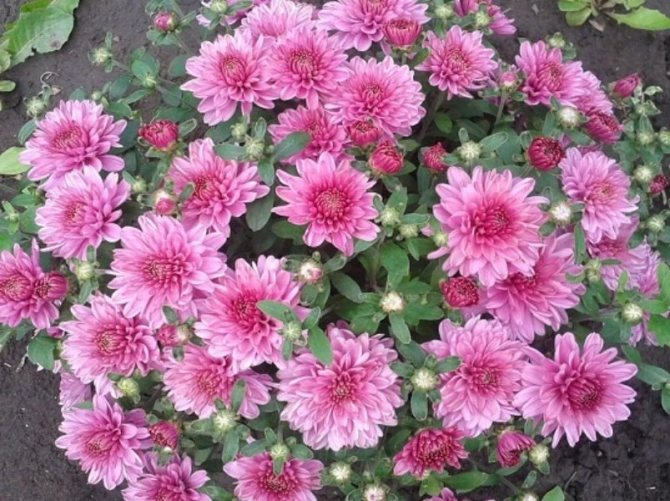
Chrysanthemum Ares - Bella: Bella Gold, Bella Pink, Bella Anna Bella Orange. Terry. Golden petals surround an orange core, pale pink - dark pink, pinkish-white - pink, orange ―brown. The bush grows up to 60 cm. The diameter of the flowers is small - 4-5 cm. It blooms in mid-September and pleases the eye with a lush bloom until frost.
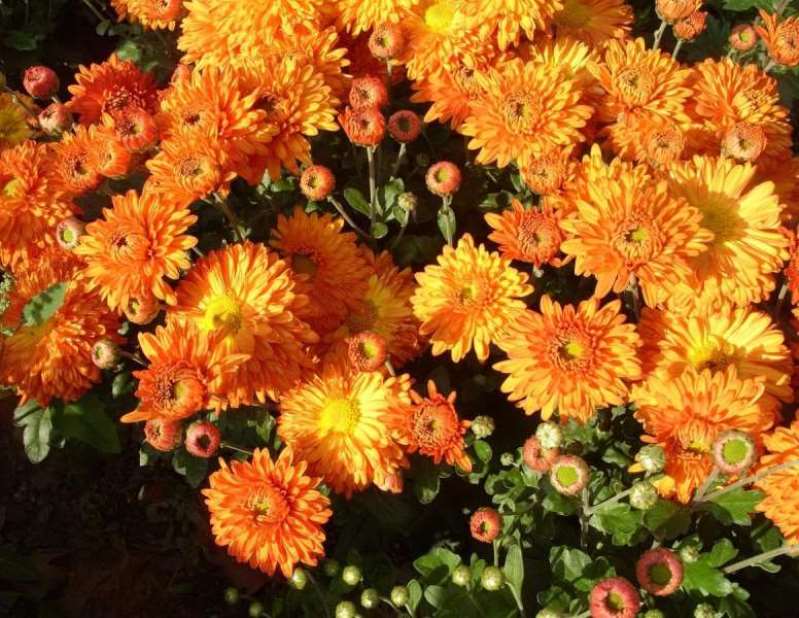

Chrysanthemum Bella Gold - Brainstorm, Brainstorm. Small-flowered royal variety of bright scarlet color. It grows up to 40 cm, the diameter of the inflorescences is 4-5 cm. An early variety of chrysanthemum multiflora: begins to bloom in mid-August.
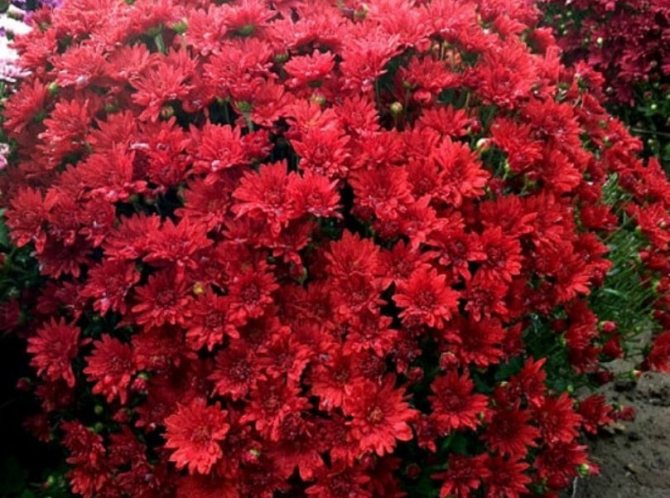

Chrysanthemum Branstorm - Chrysanthemum Multiflora Brangala (Brangala). Terry flat. The orange-coral color of the petals at the edges turns into bright yellow in the center. The height of the plant is up to half a meter, the diameter of the baskets is up to 4-5 cm.Flowering in early September. Due to its low frost resistance in open ground, it is rarely grown.
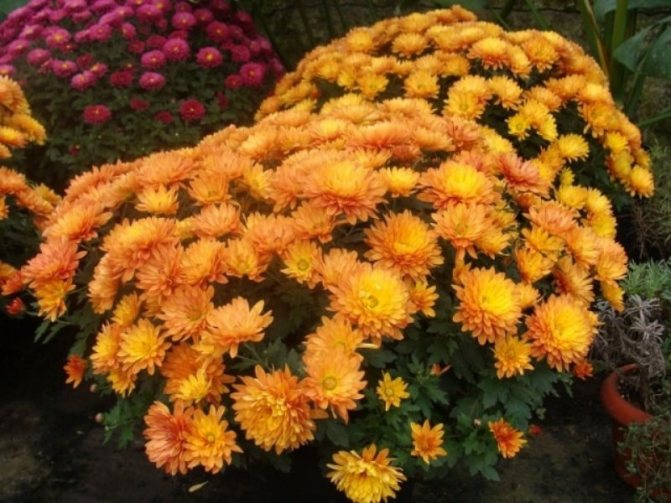

Chrysanthemum Brangala - Branbeach: Lilac (Chrysanthemum Branbeach Lilac), Orange (Chrysanthemum Branbeach Orange), White (Chrysanthemum Branbeach White), Sunny, Cream, Branbeach Coral. Terry flat. The flowers are lilac, orange, white, yellow, cream, coral, with a more intense color in the center. Plant height is about half a meter, diameter of blossoming flowers is about 6 cm. Early variety: blooms in August.
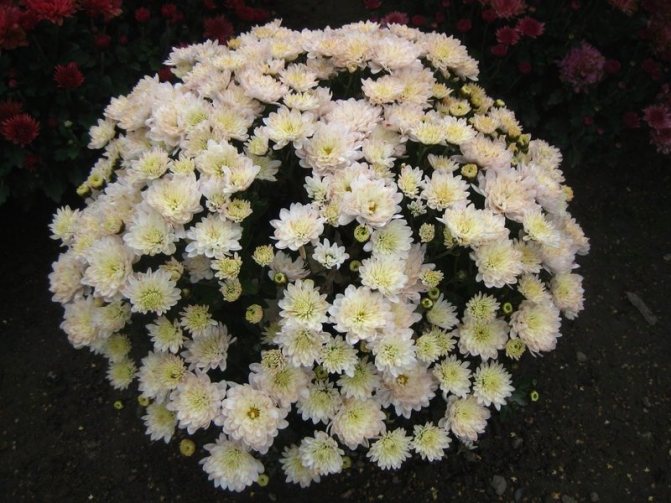

Chrysanthemum Branbeach White - Bransound: Cherry (Bransound Cherry), Bransound Lemon, Purple (Bransound Purple chrysanthemum multiflora), Bransound Pink, Bransound Mangenta. Terry. The color is cherry, yellow, purple, pink, purplish pink. The height of an adult bush is 35 cm, the diameter of the inflorescences is up to 4-5 cm.
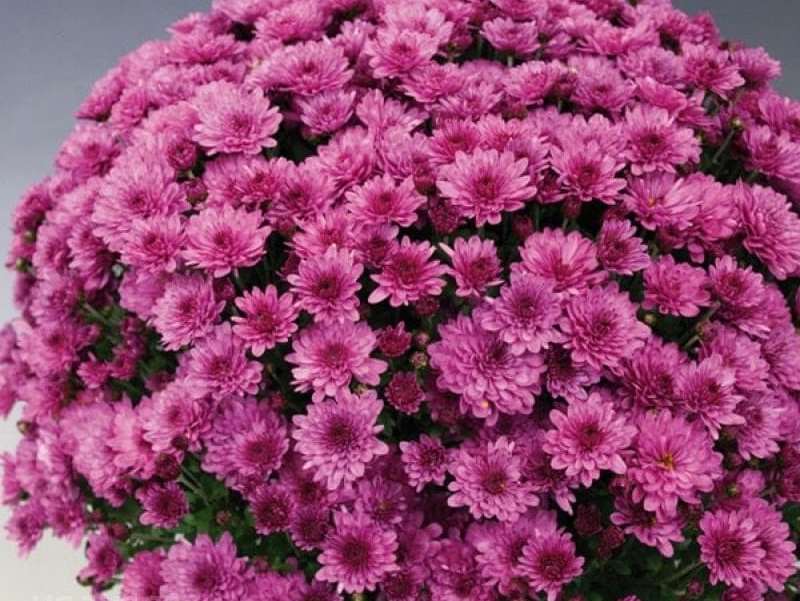

Chrysanthemum Bransound Pink - Branfortune Orange, Branfortune Red Chrysanthemum Branfortune Red. Terry. Deep orange and bright red. Early variety: the beginning of flowering is the second half of August. The height of the bush is up to 35-40 cm, the diameter of the flower is up to 4-5 cm.
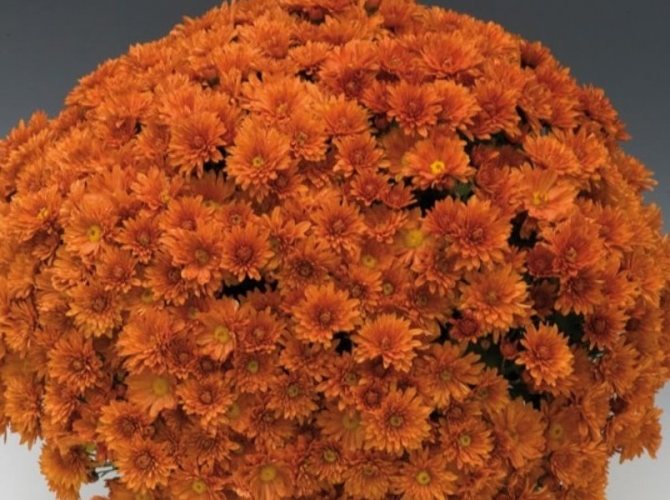

Chrysanthemum Branfortune Orange - Branfountain Lemon, Branfountain Salmon, Branfountain Ellow. Light yellow outer petals with large dark yellow, salmon pink with red-orange, bright yellow with a golden brown center. The bush grows in height up to half a meter, the diameter of the inflorescences is up to 5 cm. It blooms in the second decade of September and blooms until frost.
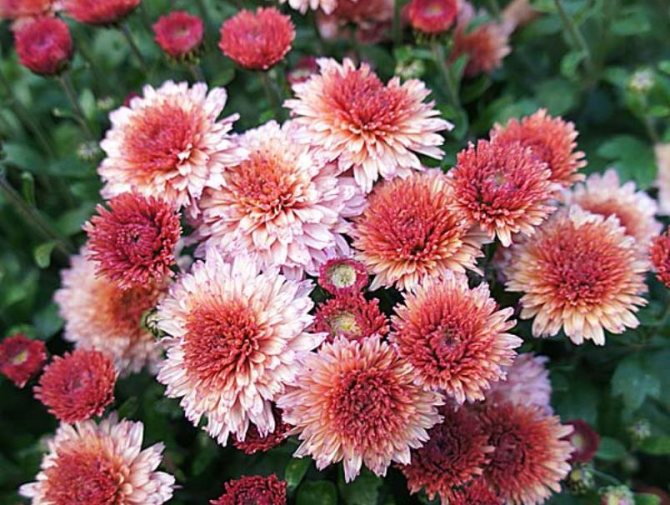

Chrysanthemum Branfountain Salmon - Branhill multiflora chrysanthemum: Branhill Purple, Branhill Red, Branhill Cherry, Branhill Orange, Branhill White, Branhill Lilac. Low-growing terry variety. The color is burgundy, red, cherry, orange, white, purple. The height of an adult plant is about 40 cm, the diameter of the inflorescences is about 4 cm. It belongs to the early winter-hardy varieties: it blooms from the second decade of August to mid-autumn.
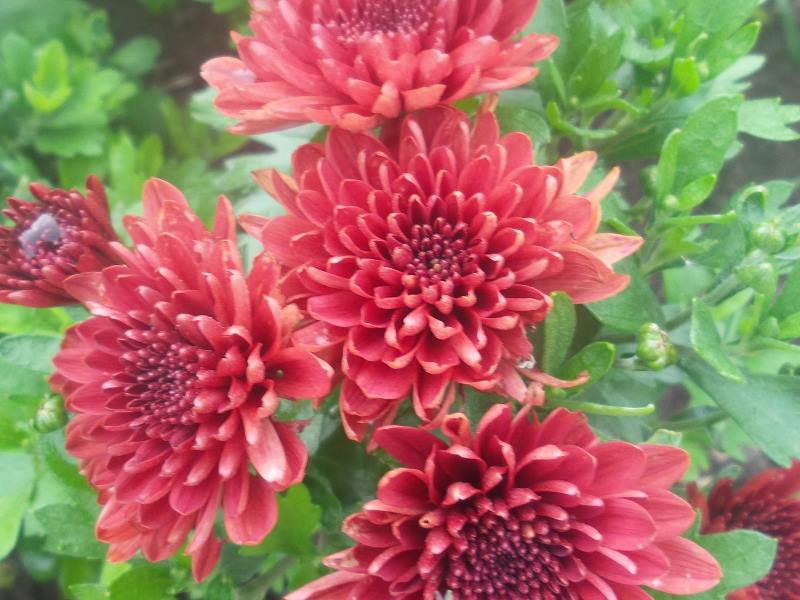

Chrysanthemum Branhill Red - Gigi (Gigi): Golden Yellow (Gigi Golden Yellow), Yellow (Gigi yellow), Coral (chrysanthemum multiflora Gigi Coral), Orange (chrysanthemum Gigi Orange), Pink (Gigi Pink), Gigi Dark Pink (Gigi Dark Pink), Gigi Snow (chrysanthemum Gigi Snow), Salmon (Gigi Salmon). Chrysanthemums are undersized, spherical, terry. The color is golden orange, bright yellow, coral, orange, pale pink, dark pink, snow white, salmon. The diameter of the inflorescences is 3-4 cm, the height of the plant is stretched no more than 40 cm. The variety belongs to the medium early: it begins to bloom in the first week of September and fades by November.
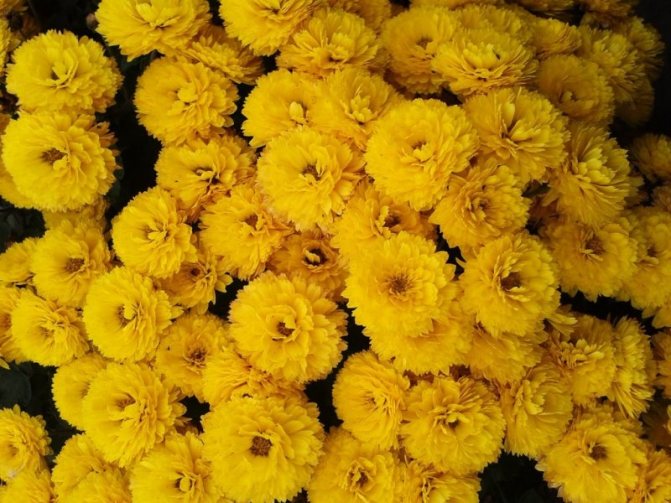

Chrysanthemum Gigi Golden Yellow - Dastino (Destino): Chrysanthemum Dustin Pink (Destino Pink), Destino Orange (Destino Orange). Terry, pompom. The color is pale pink and pale orange with darker petals around the yellow core. The compact shrub of an adult plant grows by about 40 cm, the diameter of the baskets is up to 4 cm. An early winter-hardy variety: begins to bloom in mid-August, reaches its peak by the end of September.
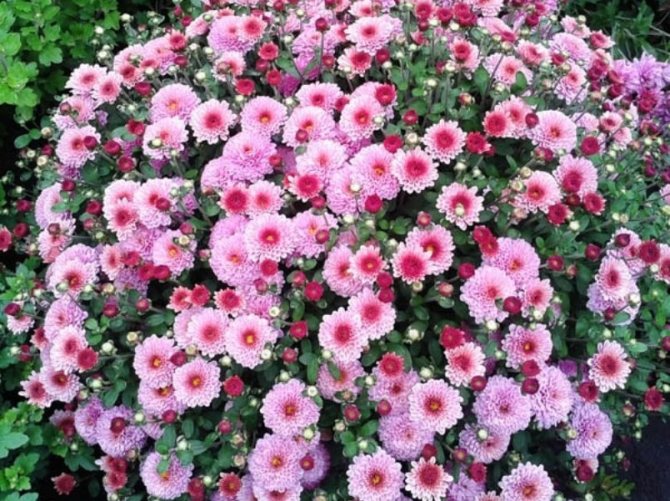

Chrysanthemum Destino Pink - Daphne: chrysanthemum Dafna Perl, Daphne White, Daphne Rose. Terry, small-flowered. A low-growing compact bush with a height not exceeding a height of up to 30 cm, the diameter of the inflorescences is not more than 3 cm. The color is milky white with a pinkish tinge and a cream center in the half-release, boiling white with a vanilla center and bright pink with a burgundy center. Chrysanthemum Daphne belongs to the early varieties: it blooms thickly and luxuriantly from the second decade of August to late autumn frosts.
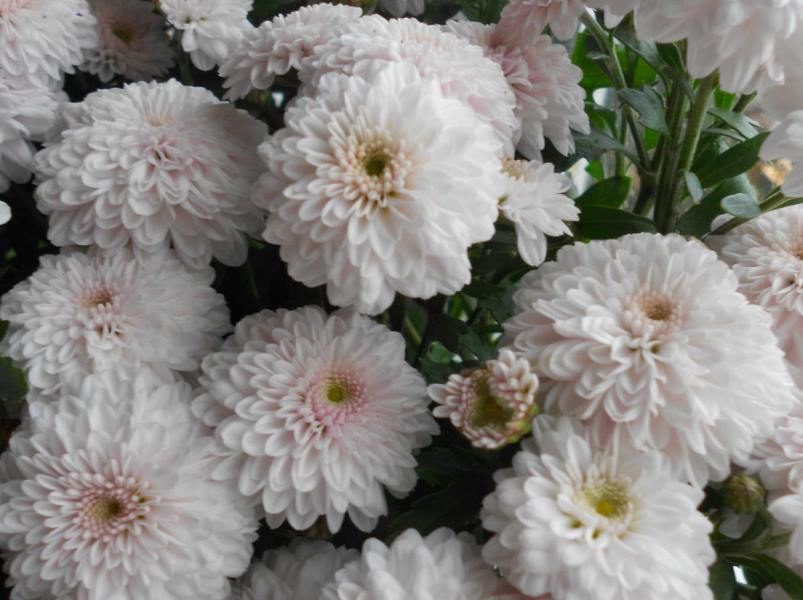

Chrysanthemum Dafna Perl - Chrysanthemum Marshmallow (Chrysanthemum Marshmallow). Lush terry. The color is delicate, lilac-pink. Quite high, grows up to 60-70 cm, inflorescences up to 6 cm in diameter. One of the earliest varieties: flowering from late July to mid-autumn.
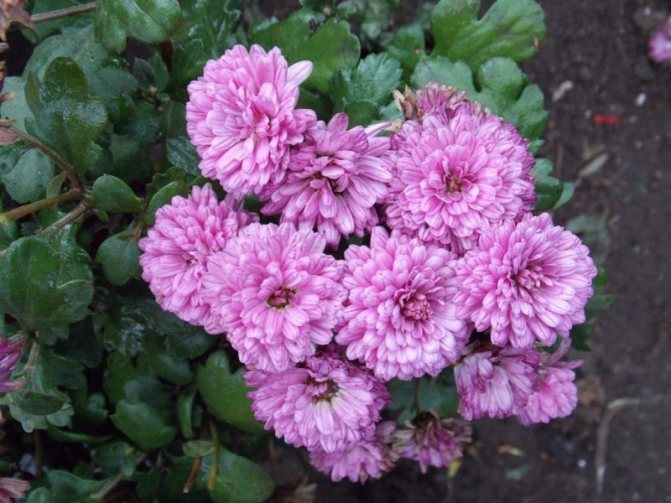

Chrysanthemum Marshmallow - Chrysanthemum Ivona. Small-flowered undersized terry Korean variety. The color of the petals is from milky white at the edges to creamy lemon in the central part. Unblown buds are brighter, shade of pink coral. The plant stretches in height by about 30-35 cm, the diameter of the blossoming baskets is about 3 cm. It belongs to the varieties of the mid-early group: it blooms from the first days of September to the end of October.
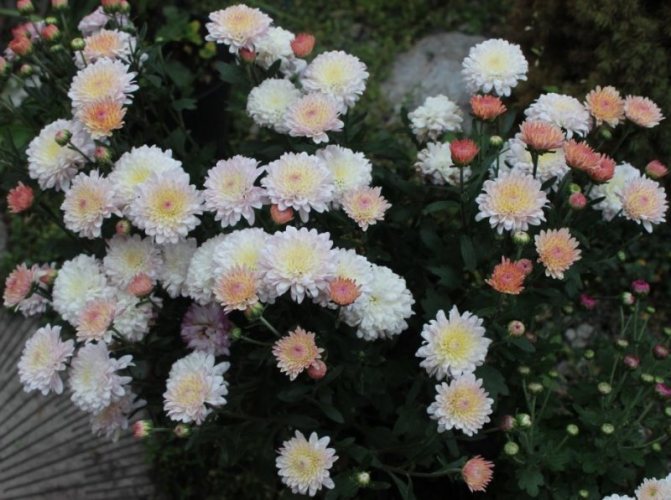

Chrysanthemum Ivona - Chrysanthemum Camina Red. Terry, small-flowered. The color is bright red. Bush height up to 40 cm, diameter of inflorescences up to 3.5 cm.Bloom from mid-September to late autumn.
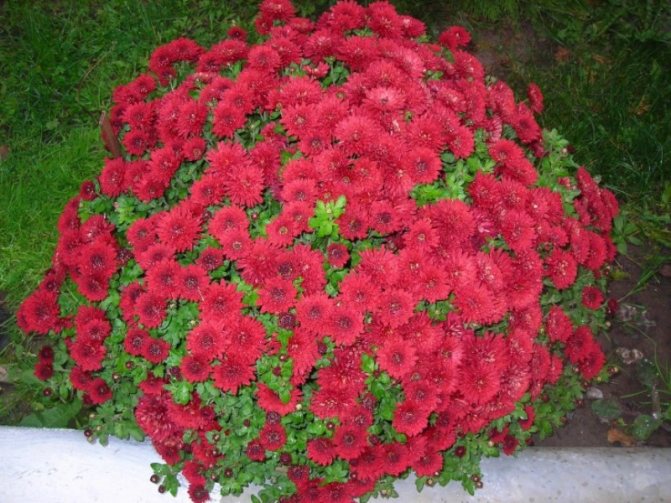

Chrysanthemum Camina Red - Chrysanthemum Knipskis. Mid-early Korean variety: blooms from late August to the last decade of September. Clove structure of the flower, the petals are coral in color, the tips of the petals are often cut. The diameter of the inflorescences is up to 4-5cm, the height of the bush is up to 40cm.
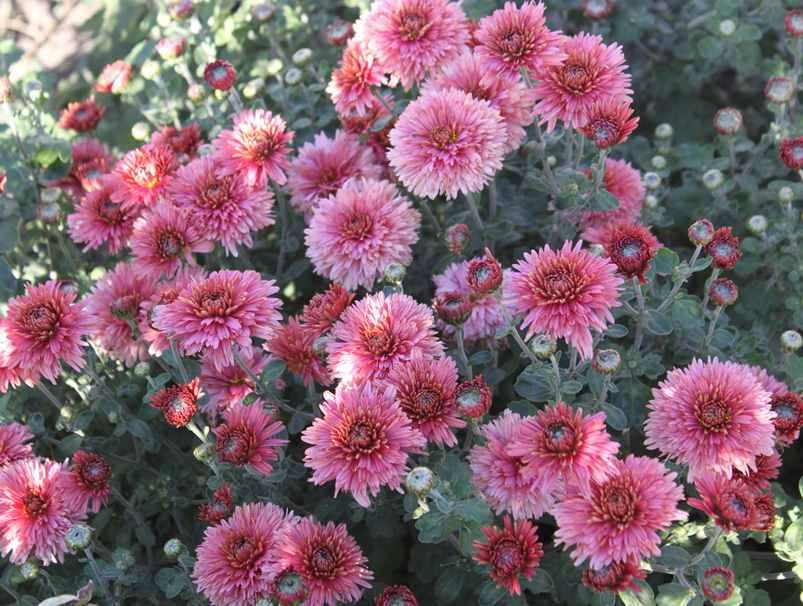

Chrysanthemum Knipskis - Chrysanthemum Coco Chanel. Small-flowered undersized Korean variety named after the famous French fashion designer. Semi-double. White with creamy petals in the center. The maximum is stretched to a height of 35-40 cm, the diameter of the flowers is up to 4 cm. It blooms from mid-September to early November.
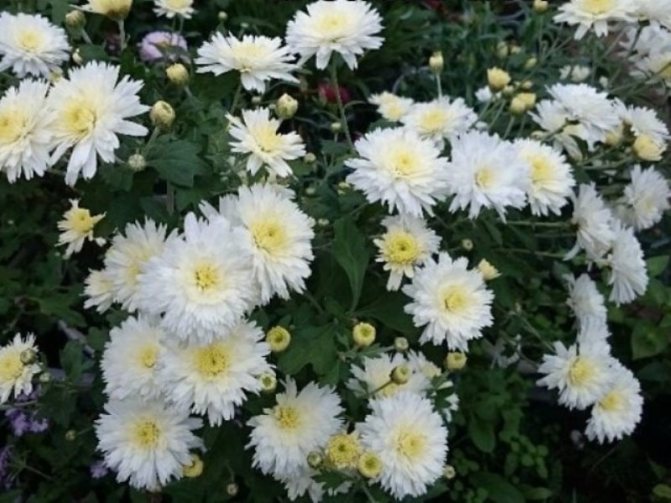

Chrysanthemum Coco Chanel - Chrysanthemum Margarita of Navarre. Stunted, densely doubled. The color is deep pink-lilac, with a white center in the dissolution. The height of the plant does not exceed 40 cm, the diameter of the lush inflorescences is about 4 cm. It begins to bloom profusely in the last decade of September and blooms until frost.
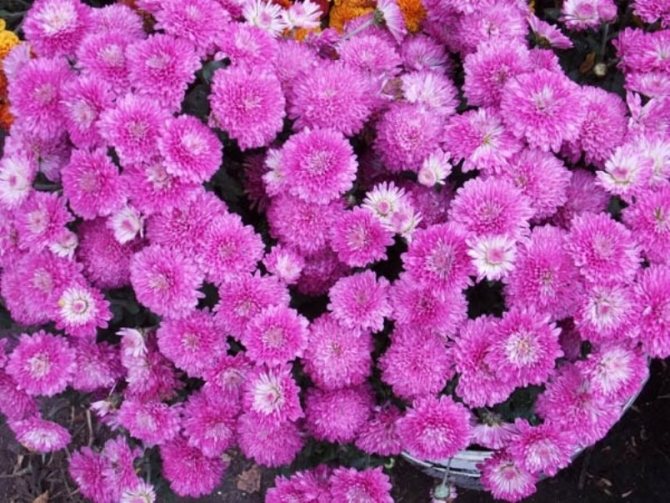

Chrysanthemum Margarita Navarrskaya - Chrysanthemum Medea (Chrysanthemum Medea). A very beautiful domestic variety, created in the Crimea. Anemoid: on a bed of wide ligulate petals, tubular petals are densely located. White with a crimson-brown dusting in the center of the flower, boiling white in full dissolution. The height of the bush is up to 50 cm, the diameter of the inflorescences is up to 4 cm. Early variety: flowering from August to September.
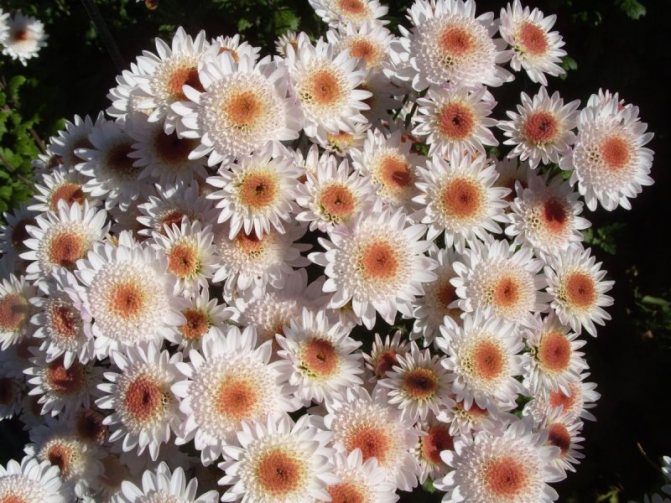

Chrysanthemum Medea - Chrysanthemum Molfetta Orange. Chrysanthemum Molfetta Pink. Korean, terry, small-flowered. Delicate pale orange and pink-lilac with more intense color of the petals in the center. The height of the plant does not exceed 40 cm, the inflorescences are 3-3.5 cm in diameter. It belongs to the middle-late varieties: it blooms in the last decade of September and blooms magnificently until late autumn.
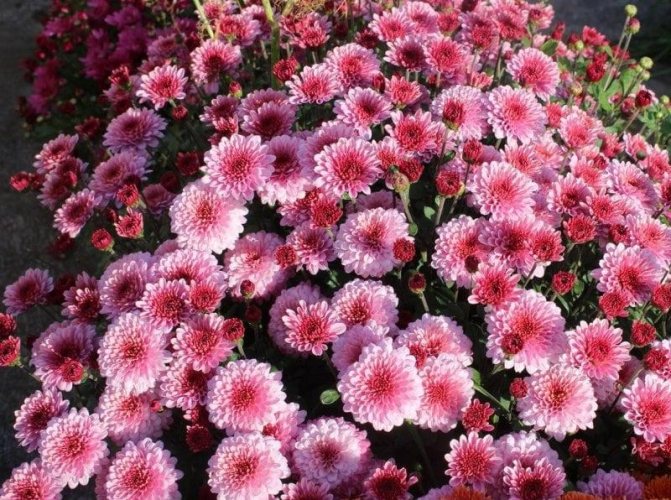

Chrysanthemum Molfetta Pink - Precocita: Pecocita Cristal, Chrysanthemum Precocita Rouge Velours, Pecocita Carna, Pecocita Perme, Pecocita Violine. Chrysanthemum multiflora white with cream, scarlet with purple, salmon with orange, pale lilac with purple, pink with a fuchsia center in dissolution. The diameter of the blossoming baskets is 5-7 cm, the height of the bush is up to 60 cm. Flowering from the beginning of September until the first frost.
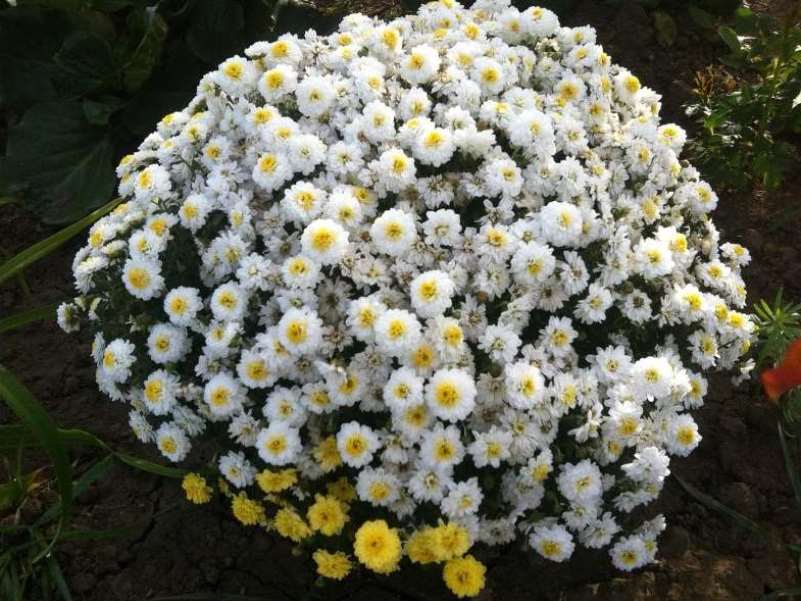

Chrysanthemum Precocita Rouge Velours - Chrysanthemum Rosanna (Rosanna). Small-flowered Korean variety of delicate pink-lilac color. It grows up to 40 cm in height, the diameter of each flower is not more than 4 cm. Densely double: the petals are elongated, in the center of the inflorescence they tightly surround the dark lilac core, the outer ones grow strictly in tiers. The color is delicate, pink-lilac. It belongs to the early-medium varieties: it blooms from the first days of September to the last days of October.
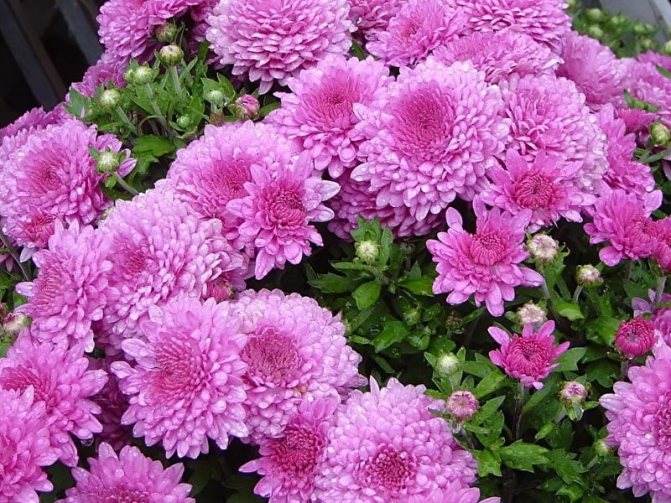

Chrysanthemum Rosanna - Chrysanthemum Silver Rain (Silver Rain, Silver rain). Terry, undersized. The petals are pink-lilac in the center, white at the edges. The foliage is silvery green. In height, the plant stretches no more than 30 cm, the maximum diameter of the flowers is 4 cm. It blooms in the second September decade and blooms until the first light frosts.
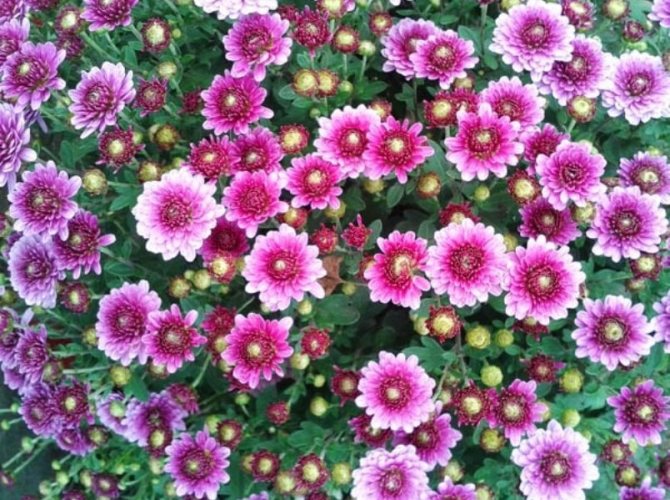

Chrysanthemum Silver Rain - Chrysanthemum Uranus (Uranus). Semi-double, undersized. The bush grows no more than 40 cm in height, the inflorescences are large enough, up to 8 cm in diameter. The color of the petals is from dark red in the half-release to bright pink at the edges. It belongs to the early varieties: it blooms from the second decade of August until the very frost.
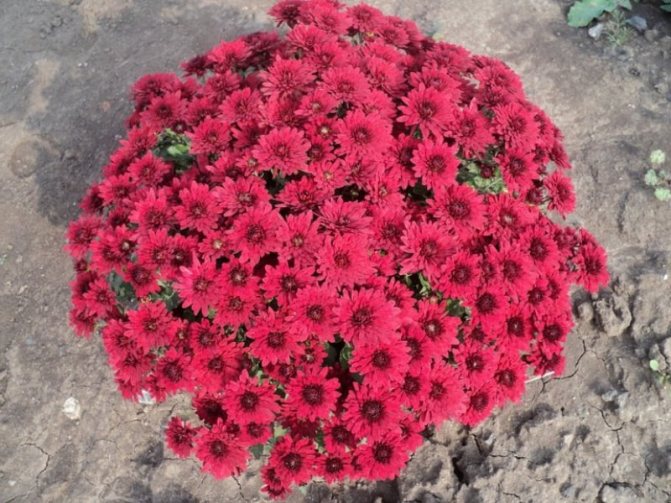

Chrysanthemum Uranus - Chrysanthemum Fantasy. Semi-double. Several rows of reed petals, ranging from pale lilac at the edges to lilac-burgundy in the center, are located around the yellow core. It can grow up to half a meter in height, the diameter of the inflorescences is up to 7-8 cm. It begins to bloom in mid-September. Frost resistant.
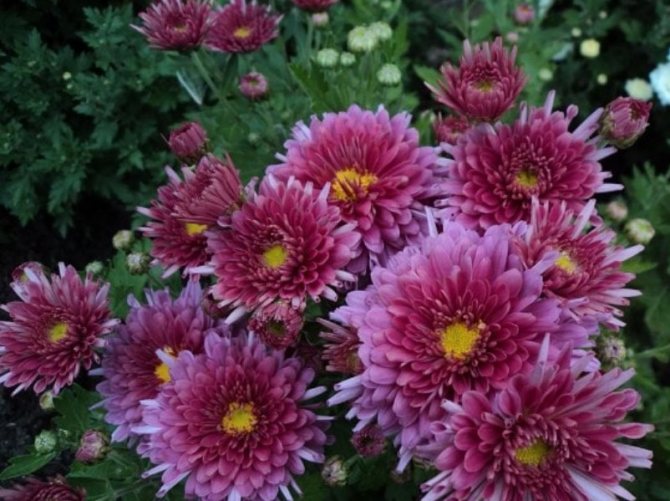

Chrysanthemum Fantasy - Chrysanthemum Elfie: Elfie Light Yellow, Elfie White. Terry, pompous. The color is pale lemon with dark yellow and white with egg petals in the center. It reaches a height of 30-35 cm, the diameter of pompom flowers is up to 4 cm. Early variety: blooms from late August to late October.
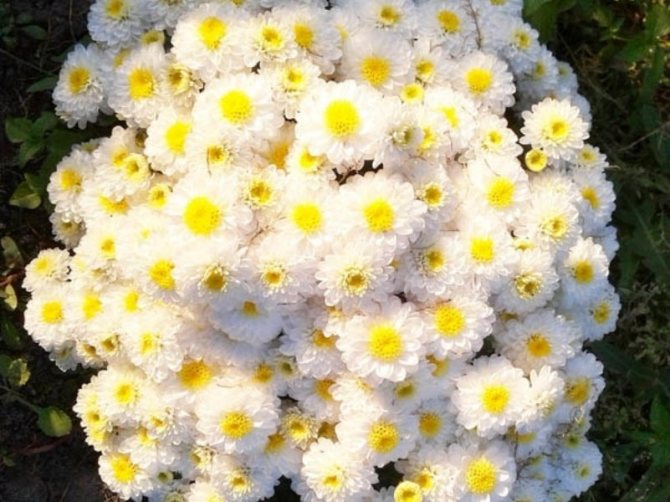

Chrysanthemum Elfie White
All articles about chrysanthemums on the site can be read by following this link ...
Varieties and varieties of border flower
All chrysanthemums can be conditionally divided into two groups:
- large-flowered (Indian);
- small-flowered (Korean).
Consider a few locally adapted cultivars.
Branfountain lemon
Delicate lemon, profusely blooming Branfountain Lemon cultivar forms a bush 50 cm high, flowering begins in early September.
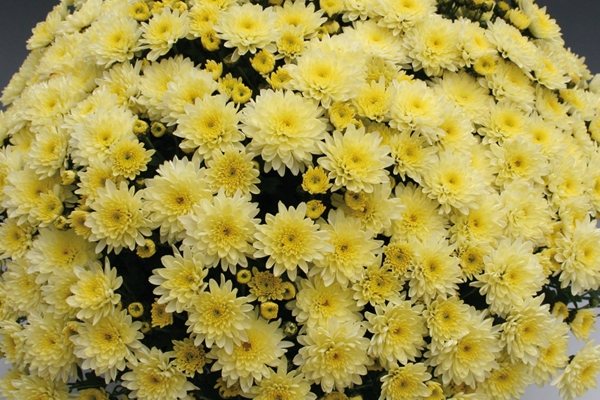

Branfountain Lemon variety
Bransky plum
Bransky Plum cultivar muted red color - rather high, a bush up to 70 cm. The variety can be interestingly beaten when creating multi-tiered garden compositions.
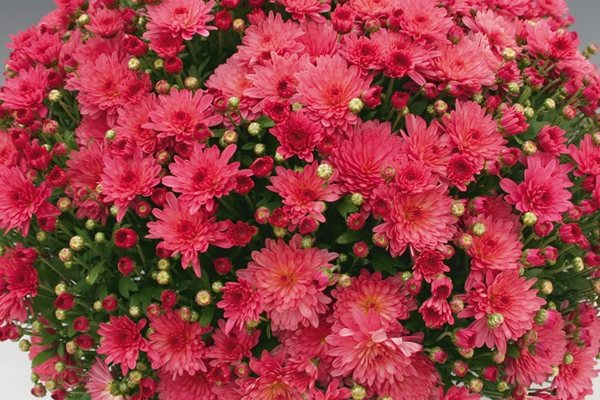

Bransky Plum cultivar
Branroyal yellow
Another high grade among spherical species - Branroyal yellow, which, during flowering, has absolutely no leaves behind the radiant yellow flowers and buds.
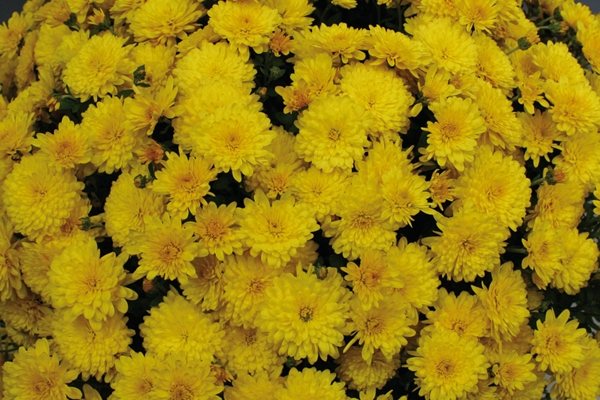

Branroyal Yellow variety
Branbeach orange
Branbeach Orange variety begins to bloom quite early, in mid-August; the height of the ball is 50 cm. The variety is attractive with a delicate orange color of the flower.
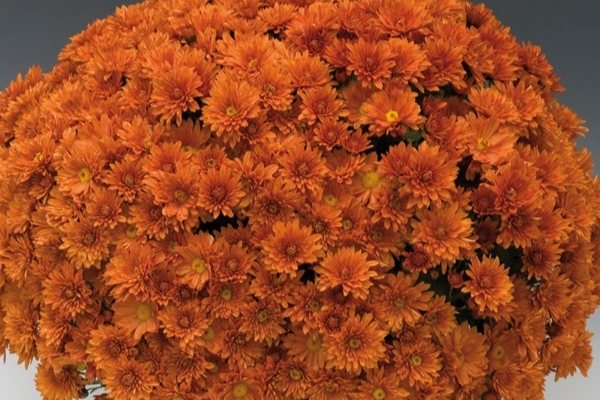

Branbeach Orange variety
Brandove white
Bicolor pom-shaped flower, light green with white, typical for Brandove White varieties, very good for creating compositions with brightly colored varieties.
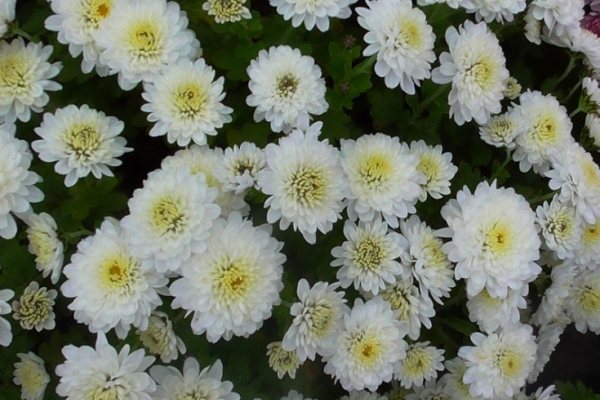

Brandove White variety
Branchili
Undersized Branchili cultivar the color of hot pepper, forms a ball 40 cm high, the diameter of the flower is 4 cm.
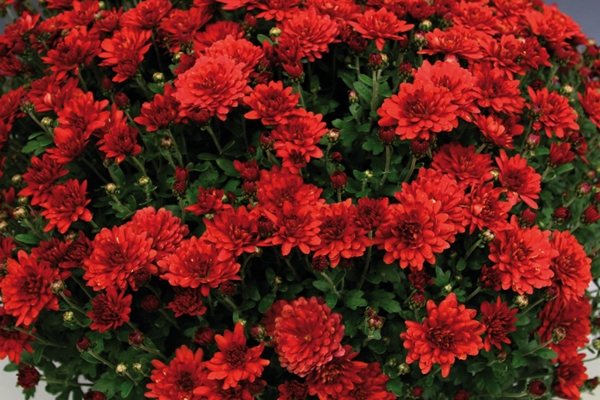

Branchili variety
These are covering varieties that overwinter quite successfully.... In northern regions, it is safer to dig up the plant by storing it in a cool, dark place.
When planting, be sure to take into account the size of an adult bush, observe a distance between seedlings of at least 50 cm.
How to plant a flower. The basics of proper care
Cultivation of spherical bushes occurs using the same technology for other chrysanthemums. Before planting, make sure to pick a spot that is fairly light, protected from drafts, flooding and stagnant water. The soil should be loose, fertile. The best time to work is mid or late spring.
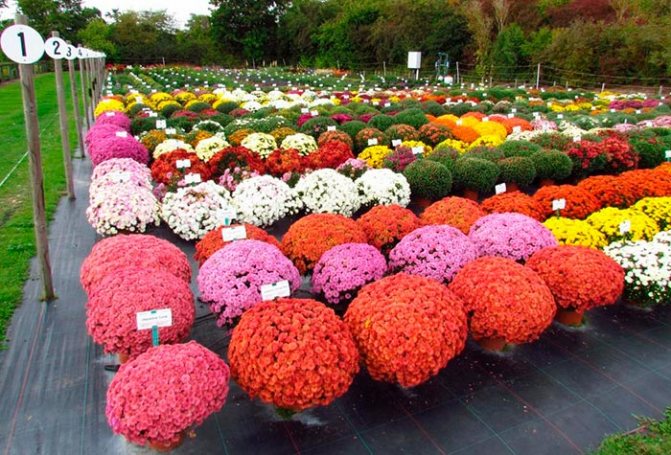

If you want to grow chrysanthemums from seeds, start germinating them back in March. Sow into a container of nutrient soil and squeeze lightly. Further procedures are standard for seedlings. In April-May, cuttings or adult chrysanthemum bushes are planted on the flower bed. The distance between the holes is about 0.6 m. Drainage must be poured at the bottom of the holes, and if the soil is not nutritious enough, fertilizer is placed (for example, peat or compost).
Advice. For cold regions, where summer "stays" for a short time, pick up early varieties. If your area has enough warm, sunny days a year, feel free to buy the late varieties. Chrysanthemum multiflora blooms calmly until snow appears.
Caring for neat bushes is also quite common. Remember to water your plants as they love moist soil. Use warm, settled water, then loosen the soil. A couple of weeks after rooting, feed the chrysanthemum with a mixture containing nitrogen, phosphorus and potassium. Magnesium is beneficial before flowering. Exclude the nitrogen component during this period.
Attention! As a rule, chrysanthemum multiflora does not need shaping. If the bush does not look like a pretty ball, it probably lacks minerals in the top dressing.
What to do after wintering?
Any wintering ends with the arrival of stable spring heat. Then multiflora wakes up, begins to grow young shoots, root shoots will appear.
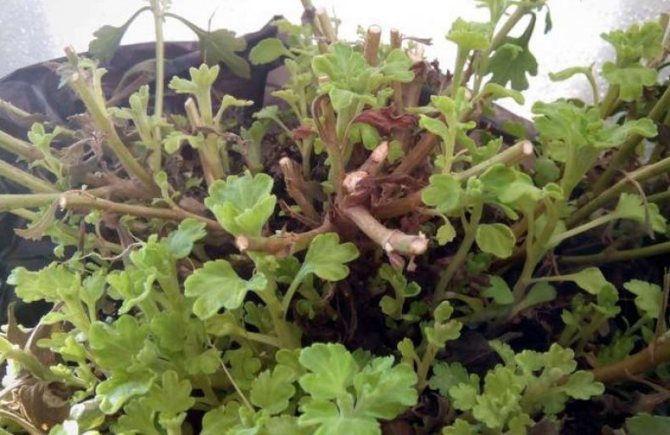

Young shoots on a spherical chrysanthemum mother plant
What to do with the overwintered plant? You can grow it further, because any chrysanthemum is a perennial. However, there is a risk that for 2-3 years of growth, the ideal ball will no longer work and the bush will fall apart. If you are growing multiflora for yourself, this is not so bad. If the correct habit is important for sale, then the old bush is used only as a mother plant. This means that it is either cut or divided, using root growth for further growing. These breeding methods for chrysanthemum multiflora are the most popular. Seed propagation is also possible, but it is rarely used.
Dividing the bush
In this case, the mother bush is divided into several plants, separating the basal shoots. This is usually done in March-April, when the growth reaches 8-10 cm. It is a small plant that has its own roots. Here they need to be very carefully separated from the mother bush, while you can use a sharp knife.
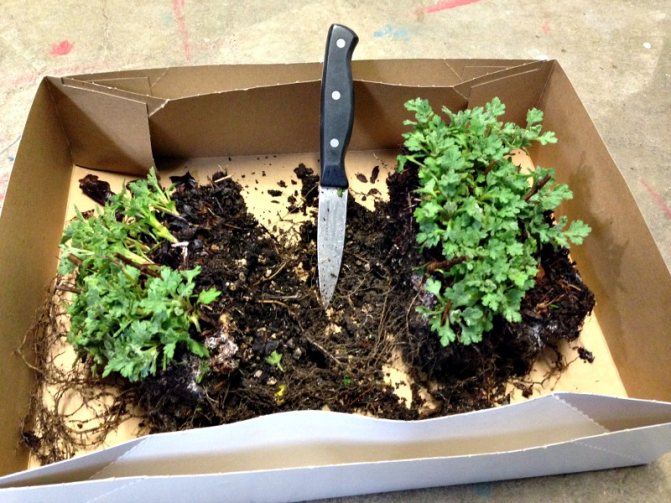

You can divide the multiflora bush with a sharp knife.
Then the cuttings are immediately planted either in open ground (weather permitting) or in a pot.
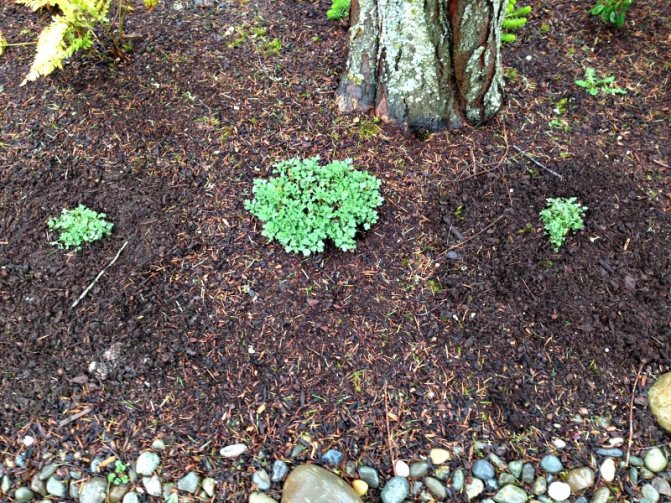

One mother bush can be divided into several young plants
The method of dividing the uterine bush of a spherical chrysanthemum is shown in the video plot:
Cuttings
Everything is simple here. When the stems grow on the mother liquor, cuttings, 4-6 cm long, are cut from them with a sharp knife or pruner. Both apical and middle cuttings are suitable - it does not matter. In any case, they can grow into a full-fledged plant and form a ball.
The lower leaves are cut off, otherwise they will be submerged in the ground or in water and will rot. Then the cutting is dipped in Kornevin (heteroauxin) and the lower internode is buried in the soil, poured into a plastic cup, cassette cell or other container.
You can also dip the cutting in Kornevin and put it in water. Chrysanthemum takes root well in water. However, if you started cutting by cuttings in the fall or winter, that is, in cold weather, it is better to prefer rooting in the ground.
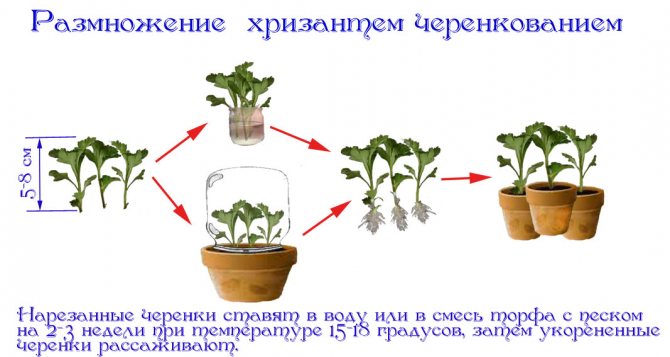

Depending on the temperature and time of year, the roots of multiflora cuttings appear on the 10-14th day.
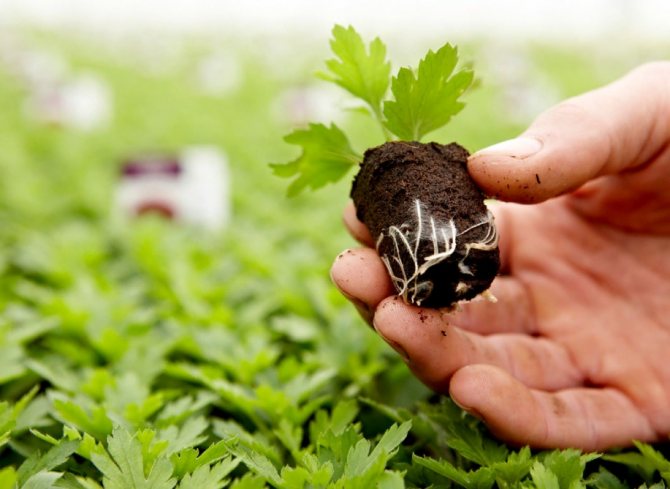

Chrysanthemum stalk gave roots in a peat tablet
Chrysanthemum multiflora cuttings are described in detail in the video:
Nutritional value and chemical composition
Energy value of dried flowers is about 24 kcal / 100 g. The product contains:
- proteins - 3.36 g;
- fat - 0.56 g;
- carbohydrates - 0.02 g.
The flowers of the plant contain biologically active substances: flavonoids, carotenoids, a complex of vitamins, coumarins, cinnamic acid derivatives, amino acids and polysaccharides.


Quantitative composition:
- flavonoids - 0.87%;
- free amino acids - 2.52%;
- vitamin A - 19.77 mg /%, E - 0.10 mg /%, C - 1.78 mg /%;
- water-soluble polysaccharides - 8.89%;
- pectin compounds - 17.79%;
- trace elements Mg, P, K, other substances.
From the handle to the blooming ball
In order for the stalk to take root well and grow, it will be necessary to comply with the following conditions:
- Abundance of light - the place for growing plants should be well lit, the length of daylight hours is more than 14 hours.
- Temperature - about 20-22 ° С
- Timely watering - both waterlogging and drying of the substrate should not be allowed.
With good care, the stalk grows quickly. As mentioned earlier, the spherical chrysanthemum does not need to be pinched. But still, some growers believe that such a manipulation will not hurt, as it makes the bush denser. Accordingly, when it blooms, more buds will appear on it. If you agree with this position, then pinch the multiflora after 4-6 leaves appear.
It is possible to plant rooted cuttings in open ground after the end of the night frosts. The sooner this is done, the larger the "ball" can grow by the fall. And the more gorgeous the bloom will be!
Cold-resistant types
The most hardy are low-growing non-double varieties. The larger and more luxuriant the flower, the less frost resistance of the plant.
Among all varieties of undersized species, the following varieties have good winter hardiness:
- Flamingo;
- Amethyst;
- Malchish-Kibalchish;
- Red Moscow;
- Everest;
- Korean;
- Purple Haze;
- Chamomile;
- Lacemaker;
- First snow;
- Umka;
- Cream;
- Korean oak.
The varieties bloom in early September and retain their decorative effect until late autumn. The inflorescences do not crumble even at sub-zero temperatures and successfully withstand temperatures as low as -5 ° C.
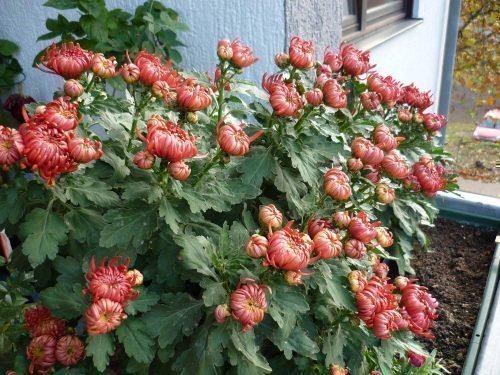

In the open field
Cold-resistant varieties of chrysanthemums are left for the winter in the open field, since their transplanting and moving to home conditions can only do harm.
To provide the bushes with a safe wintering, it is necessary to prepare and insulate them.
- First, feed the plants with phosphorus-potassium fertilizers. A mixture of double superphosphate and potassium salt is introduced under the bush. These trace elements promote long flowering, good winter hardiness and increase plant immunity.
- In the last decade of October, a sanitary shearing of the bushes is carried out - all broken, yellowed and rotten stems are cut out. This is necessary in order to prevent the appearance of fungal, bacterial infections and parasites in the crown of the plant in winter.
- All depressions and pits on the soil surface around the bush are filled up and leveled so that there is no stagnation of water. Its excess can negatively affect the condition of the root system.
- To preserve the bushes until spring, it is not necessary to cover them with plastic. Although the plant will survive under the film, it may not survive until spring - due to a lack of air, it will simply vanish. Therefore, spruce branches, sawdust, dry branches and fallen leaves are used as a shelter. If you want to cover the plants with foil, do not forget to build a frame for such a shelter. Under such a cover, the plant will not suffocate and will successfully survive until spring.
In the trenches
In a sunny, calm place in the garden or front garden, make a trench 70 cm deep and wide. The length of the trench will depend on the number of bushes.
Before laying, the bushes are trimmed, treated with a disinfectant - insecticide or copper sulfate. Rhizomes together with an earthen lump are laid tightly to each other. The voids are covered with garden soil.
Before the onset of stable frosts, the bushes are kept in the open air. As soon as the cold weather sets in, the plants are covered with a special structure that can be built from slate or reinforcement. The made box is covered with foil.
It is advisable that the plants experience the first frost in order to kill bacteria, fungus and harmful insects.
The shelter is removed in the spring, when the air temperature warms up to +10 ° C. For better adaptation, plants are watered with liquid nitrogen fertilizer - urea or slurry. Two weeks later, they are fed with superphosphate and potassium.
Benefit
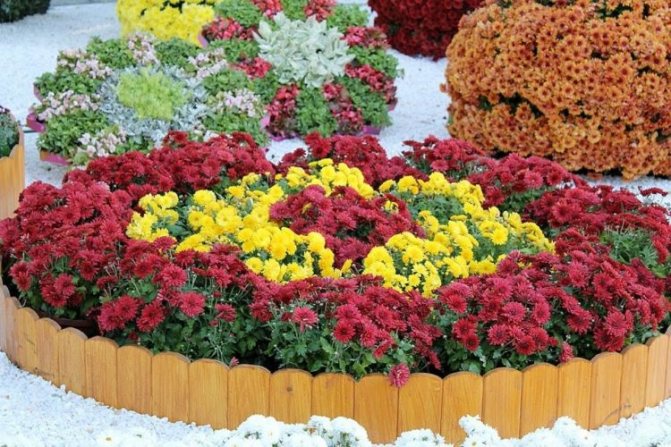

Chrysanthemums Multiflora are widely used for decorating apartments in the form of potted crops, for landscaping and creating garden compositions in summer cottages and backyards. The brightly colored spherical flower bushes bring a touch of liveliness, creating colorful landscapes and pastoral paintings.
Hand-picked inflorescences are used to brew flower tea, some lovers add young shoots to salads. They are used for medical and cosmetic purposes.
Domestic varieties
Low-growing varieties and hybrids of mulberry and Chinese chrysanthemums are suitable for growing in indoor conditions. These are miniature bushes reaching 15-50 cm in height with large or small flowers.
The most popular homemade varieties:
- Minimum;
- Red Charm;
- Yellow Charm;
- White Cascade;
- Pink Cascade.
In addition to these varieties, the spherical varieties of the Korean chrysanthemum - Multiflora - are very popular. The most common hybrids of this group are Navare, Stella, Orange Eden.
Indian house flowers in pots - Helen, Altgold, Snow Elf and Aurora - are especially attractive and decorative. Dwarf bushes grow well on the windowsill, glazed balcony. They can often be found in conservatories and greenhouses.
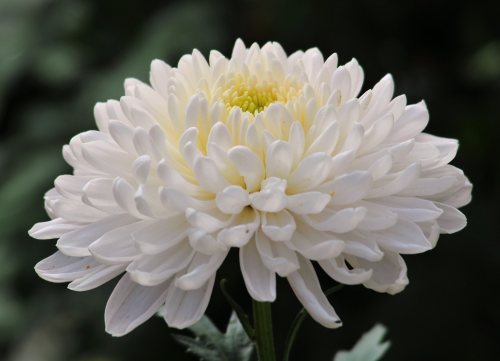

Variety White Cascade


